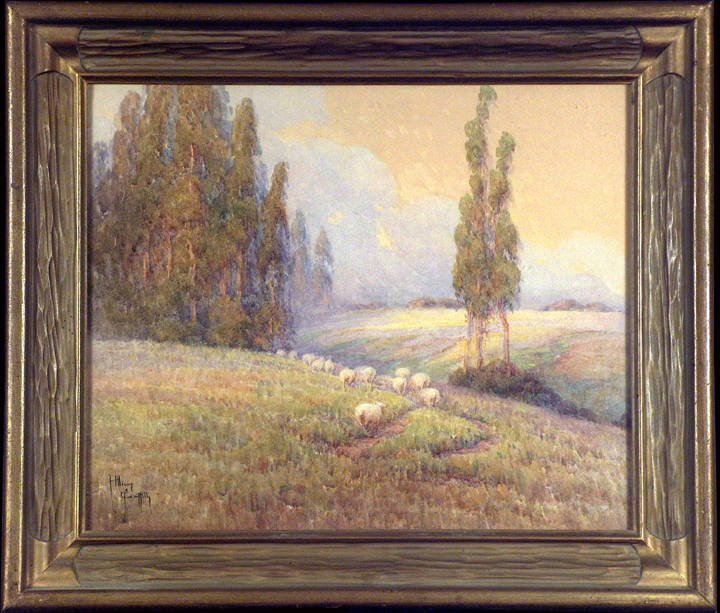As a young woman, Grace and her sister Alice had a two year long adventure on Oahu where they opened a joint gallery. After Hawaii, Grace married Charles B. Allison, and sometimes painted under the name, Allison Griffith. Meanwhile, back home, the family farmhouse burned, destroying many of Grace’s early works.
At this time 1920 - 1921 when Grace was in her mid thirties, she worked for family friend Luther Burbank creating detailed drawings of his hybrid plants.
In the 1920’s, Grace’s painting career was at its height. She visited Europe, exhibited her work in Scotland and England, and became a member of the Royal Society of London.
In her early fifties, Grace married A. O. Harris of Berkeley, and lived there until his death in 1950 when Grace was 65. She then returned to the family ranch in Sonoma County at Vine Hill, and died there in 1955 at the age of 70. Many of her paintings which survive today are pastoral and coastal scenes of Sonoma County.
* * *
There are no “hard and fast,” Rules,
only “Soft and Slow” for
Those Who Own Art
by Dan Rohlfing
Why own art? Most might think this topic probably is best addressed by students of art or by interior decorators, and certainly isn’t meant for a former history teacher turned art dealer. After all, decorators certainly have ideas of what to acquire and how best to display your art. They know the sensitivities of feng shui* and color coordination, while the art student might advise you in matching periods and styles of art in a cohesive theme.
But I’m a retired history teacher, and that teacher part of me is at my core. And from my perspective, here are my ‘soft and slow rules” for those who own art.
Like a good teacher, ... Uh hem, ... OK Class, let’s begin by using our imaginations. Imagine you in a gallery, smitten by a hundred year old painting that really speaks to your inner core. It jumps off the wall at you. You connect, respond, and are touched.
Rule # 1. If you buy this painting, you’ll never own the painting. It belongs to the artist.
Think of this painting fresh off the artist’s easel a hundred years ago. In that moment, long before your were born, and for all time afterward, that work of art belongs to artist who poured their attention, their skills, their talent, and their inspiration into it. It isn’t your painting, its their painting, their expression!
Rule #2 The painting you want to acquire has had a life before you and will live beyond you.
That piece of art you are considering has had a life before it met you. It may have hung on many walls, and based on circumstance, might well have graced an honored place in the elegant home of some prestigous personage. And after that person either died or moved it along, that same painting in later years may have spent a decade or two on the back dusty wall of a second hand store. The life of the painting you are considering has had a circuitous path through history, and if the path were known, might be more intriguing and interesting than the art itself. And, after you move on, your painting will live on.
Rule #3 After you acquire the painting, “commune” with it.
You did it! You bought it! Now, what do you do with it? I would say, don’t listen first to the decorator or the art student. Rather get to know the artist who created it. Begin with learning of their works, and study those works. But don’t stop there. Learn of their lives, who they knew, where they traveled, their traits, talents in other areas and most of all, learn of their interests beyond art.
When you hang a piece of art, you’re inviting a genius to share you home, an extraordinary person who’s artistic expression will speak to you in many different phases of light and mood, from the sunniest of days to the stormiest of nights. At the risk of having someone call the truck with the men in the white coats, I admit that as I peer into some of our paintings, I ask the artists for their ideas, suggestions and opinions. Like any conversation with trusted friends, I don’t always take their advice though, but appreciate it nonetheless.
Rule #4 Hang it, listen to it, care for it, and share it with others.
Where do you hang it? I believe you should place it where it best suits you, where you best commune with it. After all, you are the person who will spend the most time with it. A painting should have good light and should be located where it can best be appreciated. Some paintings are “close up” paintings, and will do well with a short viewing distance while others need the length of a hallway to show off their “distance” qualities. Depending on the piece, you may also want to display it where it can best be appreciated by your friends, where you can tell the stories of what the painting means to you, the stories of the artist, and the stories of what others have said having seen your painting.
Hey, these rules aren’t hard and fast, but they are from a history teacher who wants to invite and welcome new eyes to view old art, and come to appreciate and love art for all that it can be. Like a lovable pound puppy, maybe you should find some art you can’t resist, and give it a new and loving home.
Today’s vocab lesson ...
Feng shui, pronounced in English as "fung shway", is the ancient Chinese practice of placement and arrangement of space to achieve harmony with the environment. The literal translation is "wind-water".
“A work of art which did not begin in emotion is not art.” Paul Cezanne |

